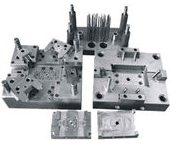Thermoplastic injection or injection molding in rapid prototyping is often commonly referred to as “aluminum plastic injection”. It consists of injecting a plastic material into an aluminum mold. Due to its cost and installation, this technique is the closest to series production. It is recommended for productions from one hundred to several thousand parts in the “right material” which can be marketed or used in transition production.
Advantages of thermoplastic injection
- High precision, fine detail: the finished aluminum mold makes it possible to obtain finished parts, in complex shapes, for parts weighing a few grams to several kilograms. By using thermoplastic injection, it is often not even necessary to perform post-production machining.
- Quality of the part: the use of the “right material” for the injection gives the parts made by thermoplastic injection the robustness and mechanical properties of series parts. This makes it possible to perform tests or even market a small series. The use of mold also guarantees excellent quality of all the parts produced.
- From smallest to largest: injection molding (or thermoplastic injection) requires the creation of a mold that can be very small or very large, depending on the needs, while maintaining high precision. This is why this method of rapid prototyping is used in the medical and automobile fields.
- Prices and deadlines: if the underlying investment is expensive, thermoplastic injection or injection molding uses an aluminum mold, which is cheaper than the steel molds commonly used in the production of series parts. This allows costs to be reduced while ensuring the production of a hundred to several thousand parts and maintaining the same quality of execution. Once the mold has been produced, it also guarantees the rapid production of a large quantity of finished parts.
Limitations of thermoplastic injection
- Production of large quantities: given the rather large investment associated with the creation of molds, the thermoplastic injection method is more cost-effective for large-scale production. It is not recommended for the production of fewer than 100 parts.
- The lifetime of the mold: if aluminum is used to reduce the mold design costs, it is nevertheless less solid than steel. Therefore, the lifetime of the mold is limited and does not allow the production of more than a few thousand parts.
- Longer process: due to the need to create a mold, thermoplastic injection is longer than 3D printing, and is not suitable for urgent requests.
Recommended uses of thermoplastic injection
For all the reasons mentioned above, thermoplastic injection or injection molding is recommended for:
- mechanical tests
- production of one hundred to several thousand parts
- small-scale commercialization
- transition production

